Tasks Due Today
- Review and Submit Your Learning Plan
- Get LinkedIn Learning with your Public Library Card
- Review Laying the Groundwork for Design Theory
- Review Setting up Hypothesis for offline PDFs
- Assignment: Reading Response 2
- Submit Week 2 Agenda Checklist
This Week’s Topics
- Checkin & Share
- Signs and Meaning in Communication Design
- Discussion
- Models of Communication
- Assignment: Reading Response 3
- Week 3 Agenda Checklist
At the end of this session, students should have an understanding of the following:
- Semiotics and models of communication and how they are relevant to Communication Design.
- The guidelines and due date for Reading Response 3
Check-in & Share (15+ min)
Share
Share an image, video, or link that you added to your Research Journal this week. Let’s consider and discuss how it reflects your story as a designer or global citizen, why you chose it, and if it fits within your design aesthetic or ideology.
Meeting request
Please sign up for a remote meeting next week. If you are not available during the meeting slots, please contact me to find another time.
- Monday 1pm-4pm
- Tuesday 10am-12pm
- Wednesday 7pm-9pm
Use the Zoom Link to join the meeting.
Reading Response #1 Feedback
Let's take a closer look at the Reading Response #1 guidelines and our Hypothesis annotations to make sure we are all on the same page. Compare your response with the guidelines and the sample post.
I've added a private comment to your Reading Response post. I'm still going through and adding inline feedback using Hypothesis. Once complete, review the comments and revise your work based on feedback/questions as well as discussions with your classmates.
Inline feedback via Hypothesis will be added to your post. View the feedback like this:
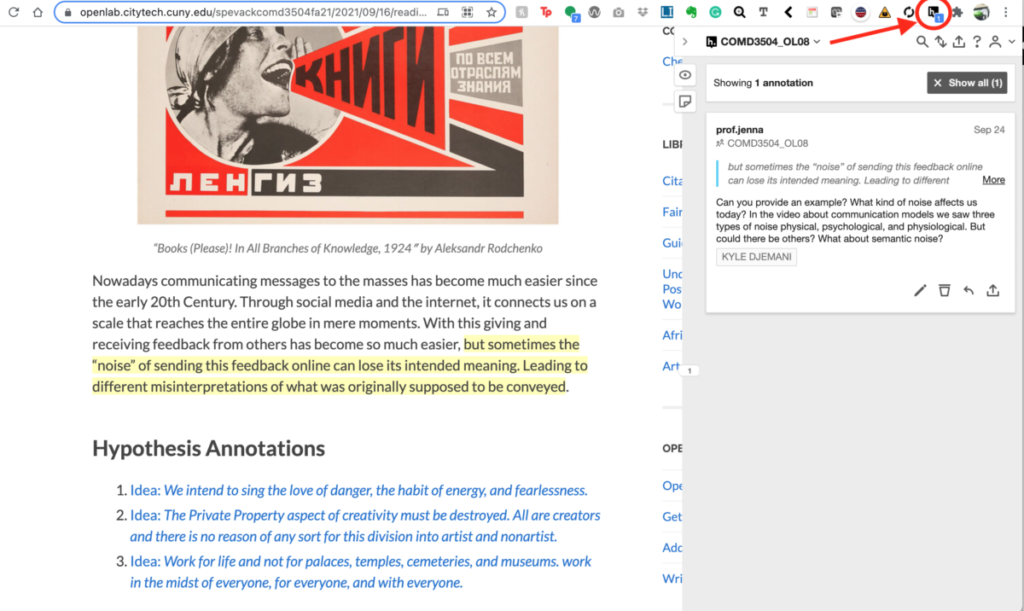
If you have any questions or concerns, please contact me.
Activities
Below find the information covered in this session. Complete all of the following activities, videos, and assignments.
1. Signs and Meaning in Communication Design (30 min)
Our second reading assignment from Sean Hall was an introduction to semiotics and methods of communication. As we discovered in the reading, the field of semiotics, influenced by Ferdinand de Saussure, is defined as the theory of signs.
"signing is vital to human existence because it underlies all forms of communication."
Sean Hall, This Means This, This means That
Ferdinand de Saussure, often called the father of semiotics, identified a sign as composed of a signifier and a signified. The signifier is the sound-image that we see, speak or hear to refer to the sign. The signified is the concept that our mind conjures in relation to the sign. The sign is the whole of these parts.
- Sign: A sign is anything that creates meaning composed of a signifier and a signified.
- Signifier: A word, an image, a sound, anything we see, speak or hear to refer to the sign.
- Signified: The concept that our mind conjures in relation to the sign.
In the image below we can locate several signs. One example is the apple. When you see the apple, you recognize it as a familiar piece of fruit. The same is true if we saw or heard the word “apple” or if we speak/read another language: “苹果” or ” تَفَّاحَة” or ”manzana.”
The representation of the apple is a signifier. The concept that our mind conjures when we see this image is the signified. Together these make up the sign.
The context also matters. In this painting, if we are familiar with the story of Adam and Eve, the signified is also “temptation.”

Forms of signs
The signs we use to communicate are arbitrary, and their meaning develops over time. Charles Sanders Pierce, another important figure in the field of semiotics, showed that signs can take different forms.
- Icon: signifier resembles the signified (e.g. a graphic image of a dog resembles an actual dog)
- Symbol: arbitrary learned relationship between the signifier and signified (e.g. we must learn from others that a dollar sign $ refers to money)
- Index: signifier is caused by or linked to the signified (e.g. we associate smoke with fire)

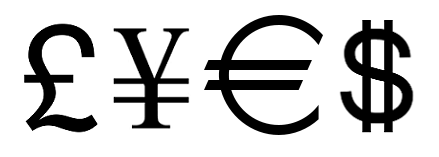

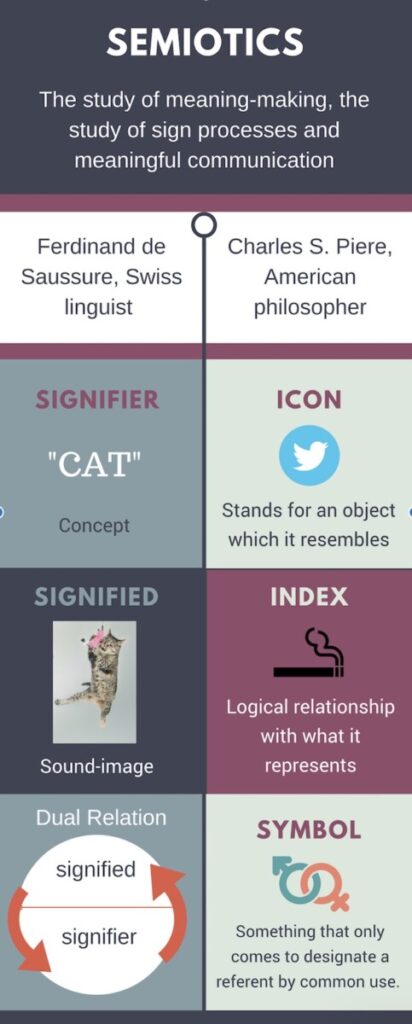
Non-literal / Rhetorical forms
As visual designers, we use language as words and images to communicate with our audience. It’s important to understand how meaning is made through communication and to be aware of how our messages are being transmitted and received. Non-literal forms of communication are important for design, advertising, illustration, filmmaking, fashion, and journalism because they help with the transmission of meaning. they can be persuasive, but depending on the audience, but can also confuse meaning.
Examples are simile, metaphor, metonym, synecdoche, irony, lies, impossibility, depiction, and representation.
These are explained in the chapter “Ways of Meaning” in This Means This, This Means That: A User’s Guide to Semiotics by Sean Hall and also in “Rhetorical Tropes” on the website Semiotics for Beginners by Daniel Chandler.
- Simile is comparison through the use of the word 'as' or 'like.' > "Like a Rock"
- Metaphor is a form of figurative or nonliteral language. > "Red Bull Gives You Wings!"
- Metonym (meh·tuh·nuhm) is when one thing stands in for another thing that is directly related to or closely associated with it. > The NY Theatre scene is referred to as "Broadway"
- Synecdoche (suh·nek·duh·kee) another type of metonym, using a phrase or visual that contains part of the whole to represent one of its parts or vice versa. > A brand name stands in for a type of product. Band-Aids and Kleenex
- Irony is a technique used by storytellers to contrast expectations with reality, often in an amusing way. > Some examples in advertising
Red Bull uses metaphor in their advertisements: Red Bull Gives You Wings! Drinking Red Bull doesn’t literally cause you to grow wings, but rather we relate it to gaining metaphorical flight in terms of energy or power. The definition of “give wings to” means to inspire or motivate someone to “fly” or soar – to achieve great things. Interestingly, Red Bull was sued for false advertising.
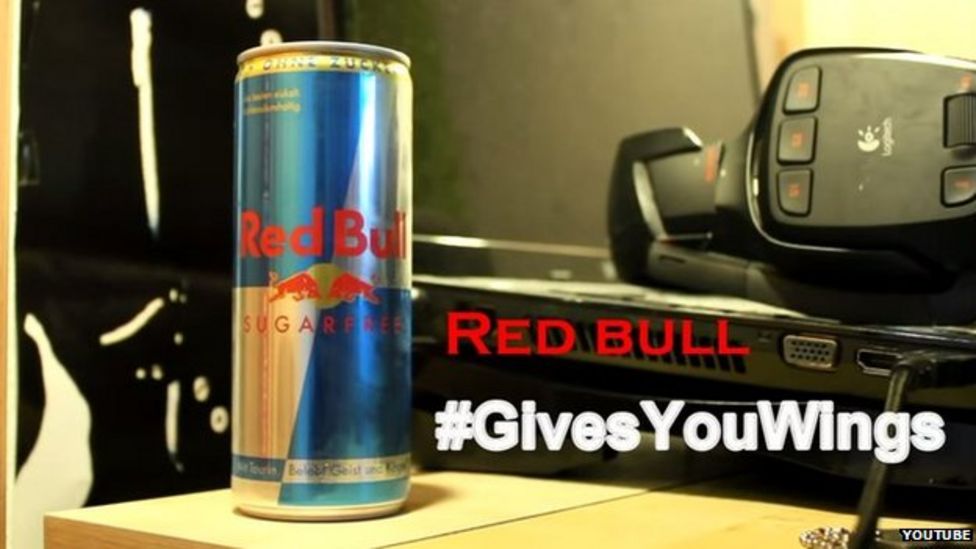
Check out the following videos to reinforce the following concepts: sign, signifier, signified, icon, index, symbol.
2. Discussion (30-45 Minutes)
Break into groups and share your reading response & examples with your group. Collectively, decide on the best examples from each of the following and share it with the class.
- Using an example, define Saussure’s terms sign, signifier, and signified in your own words.
- How are signs employed in visual communication? Provide a visual example from contemporary or historical advertising and explain why the example is considered an icon, index, or symbol in Peirce’s terms.
- How are non-literal devices used to convey meaning in advertising and/or social media? Provide a visual example from contemporary or historical advertising and explain which type of non-literal device (simile, metaphor, metonym, synecdoche, irony, lies, impossibility, depiction, or representation) is being used and why.
3. Models of Communication
Careful analysis of the message cycle can help us to understand when our communication works and when it doesn’t and why. If we are aware of these concepts and the communication process, we can be more effective communication designers!
- Messages take different paths between the sender and receiver and back again via different mediums.
- Noise is the distortion in the meaning of a message, whether intended or not. It affects whether or not the message has successfully reached its destination.
- Truth in communication. Where a message says it is from may be very different from where it is really from. It can sometimes be hard to determine the intention of the sender, and that can affect how we receive the communication.
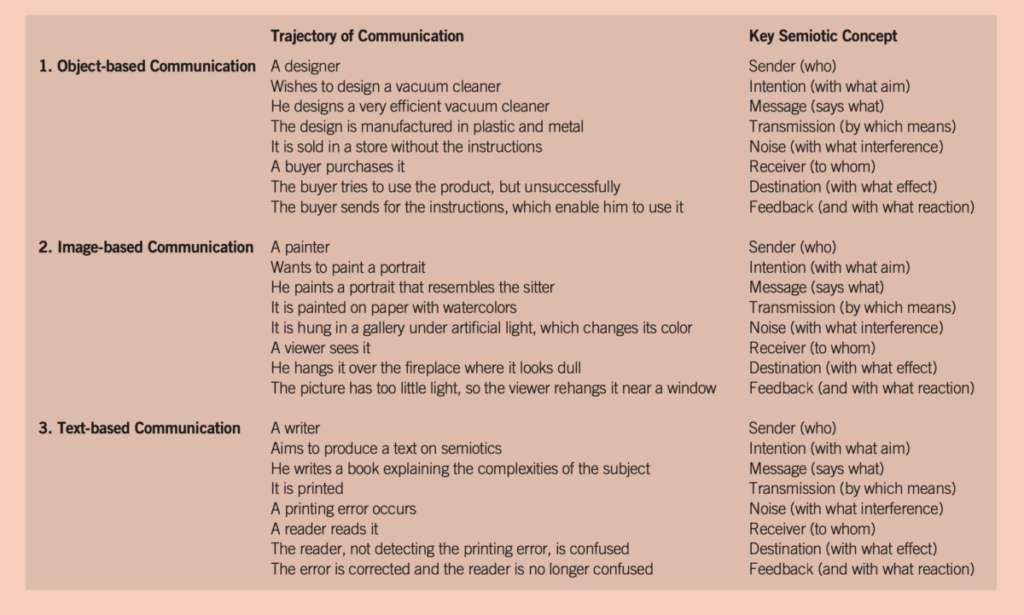
Check out the following videos to reinforce the following concepts: sender, intention, transmission, noise, receiver, destination, feedback.
We will come back to Communication Models as they relate to contemporary digital communications, specifically social media, in later weeks.
If you'd like to get a head start on those communication models, check out this essay "Communication Theory & Social Media", Leah Sutherland, LinkedIn, July 6, 2015
4. Assignment: Reading Response 3 (2+ Hours)
Follow the assignment guidelines and prompts in the Reading Response 3 guidelines. DUE Wednesday before the next class.
Avant-garde Manifestos: You will be reading and annotating three texts written by members of the early avant-garde Futurist and Constructivist Movements: F.T. Marinetti, “Manifesto of Futurism”; Aleksandr Rodchenko, “Who We Are: Manifesto of the Constructivist Group”; and El Lissitzky, “Our Book” with your classmates in our Hypothesis group. These are found in our main text Graphic Design Theory: Readings From the Field by Helen Armstrong on pages 19-31.
After annotating the text, create a rough draft of your response in your Research Journal. Your response should be about 200 words and checked for spelling and grammar errors. Publish your finished response on the class site, using the Reading Response 3 guidelines provided.
Resources
- Assignment: Reading Response 3
- Using Hypothesis
- Research Journal
- Reading Response (Example) post
- Grammarly
Week 3 Agenda Checklist
Below are all of the tasks, big and small, for this week. The due date is Wednesday, 11:59 pm before our next Thursday class. Timely completion of these tasks will contribute to your success in this course.
If you have any questions, don’t hesitate to reach out.




Leave a Reply